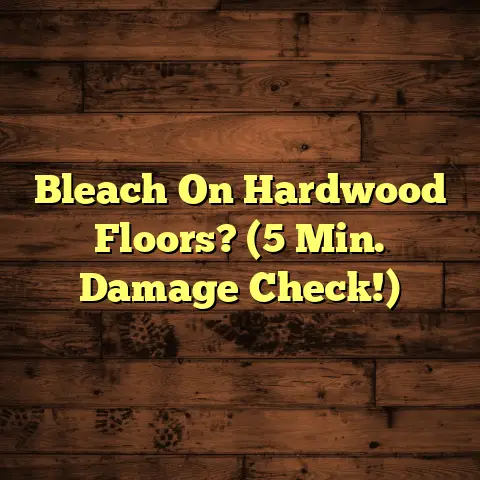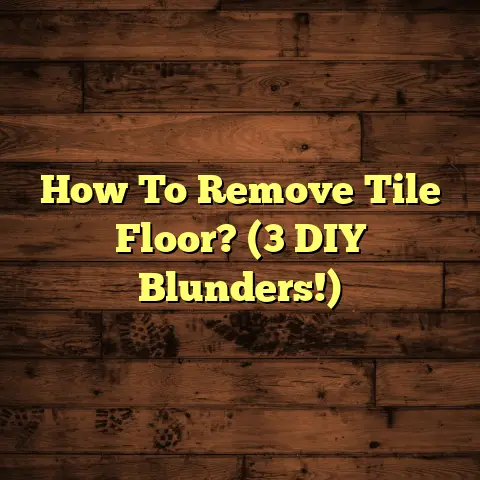30-Year Laminate: Worth It? (4 Wear Layer Facts!)
Isn’t it amazing how much a simple change can transform a space?
I’m talking about flooring, of course!
As a flooring contractor for over 15 years, I’ve seen it all.
And believe me, the right floor can completely redefine a room’s aesthetic and functionality.
That’s where 30-year laminate flooring comes in.
It’s not just about slapping down some new boards; it’s about investing in long-lasting beauty and durability.
Plus, the ease of installation means you can switch things up without a full-blown renovation.
Sounds pretty good, right?
Let’s dive in and see if it’s the right choice for you.
Introduction to 30-Year
Laminate Flooring
So, what exactly is 30-year laminate flooring?
Well, it’s a type of synthetic flooring designed to mimic the look of natural materials like wood or stone, but with enhanced durability and a longer lifespan.
Think of it as the superhero version of traditional laminate.
The secret?
Technological advancements in manufacturing.
We’re talking about high-density fiberboard (HDF) cores, superior locking systems, and, most importantly, incredibly tough wear layers.
These advancements contribute to a floor that can withstand the daily grind of a busy home for, you guessed it, around 30 years!
And the styles?
The possibilities are endless!
You can find laminates that perfectly replicate the grain and texture of hardwood, the cool elegance of stone, or even more modern, abstract designs.
Whatever your style, there’s a 30-year laminate out there to match.
Understanding the Wear Layer
Now, let’s talk about the real star of the show: the wear layer.
What is it, and why should you care?
Simply put, the wear layer is the top surface of the laminate flooring that protects the underlying design layer from scratches, stains, fading, and general wear and tear.
Think of it as the floor’s bodyguard.
The thicker and more durable the wear layer, the longer your floor will look its best.
You’ll often see wear layers rated using an “AC” rating, which stands for Abrasion Class.
These ratings range from AC1 to AC5, with AC1 being suitable for light residential use (like bedrooms) and AC5 being tough enough for heavy commercial traffic (like retail stores).
A 30-year laminate will typically have a higher AC rating, usually AC4 or AC5, indicating its ability to withstand significant wear and tear over an extended period.
So, what does a 30-year wear layer really mean for you?
It means you can expect your floor to resist scratches from pets, dents from dropped objects, and fading from sunlight for decades, not just years.
It’s a promise of longevity and lasting beauty.
Four Key Wear Layer Facts
Alright, let’s get down to the nitty-gritty.
Here are four crucial facts about wear layers that will help you make an informed decision when choosing your 30-year laminate.
Fact 1: Thickness Matters
This might seem obvious, but the thickness of the wear layer is a major factor in determining its overall durability.
Think of it like this: a thicker wear layer is like a thicker shield.
It can absorb more punishment before showing signs of wear.
Generally, wear layers are measured in millimeters (mm) or mils (thousandths of an inch).
A typical residential laminate might have a wear layer of 8mm to 12mm or 12 mil.
A 30-year laminate, on the other hand, will often have a wear layer of 12mm to 14mm or 20 mil or higher.
Here’s a quick comparison:
- 8mm (12 mil): Suitable for low-traffic areas like bedrooms or guest rooms.
- 10mm (15 mil): A good all-around option for general residential use.
- 12mm (20 mil): Ideal for high-traffic areas like living rooms and hallways.
- 14mm+ (20+ mil): The best choice for demanding environments with heavy foot traffic, pets, or kids.
From my experience, investing in a thicker wear layer is almost always worth the extra cost, especially if you have a busy household or pets.
It’s like buying insurance for your floor!
Fact 2: Resistance to
Fading and Stains
Let’s face it: life happens.
Spills, accidents, and exposure to sunlight are inevitable.
That’s why a good wear layer should be designed to resist both fading from UV light and staining from common household liquids.
High-quality 30-year laminates often incorporate UV inhibitors into the wear layer, which help to prevent the color from fading over time, even in sunny rooms.
They also feature stain-resistant coatings that make it easy to wipe up spills without leaving behind unsightly marks.
I’ve seen firsthand how this feature can save homeowners from major headaches.
Imagine spilling a glass of red wine on your brand-new floor.
With a cheap laminate, you might be looking at a permanent stain.
But with a 30-year laminate that has a quality wear layer, you can simply wipe it up and move on.
Fact 3: Ease of Maintenance
Who wants to spend hours scrubbing and polishing their floors?
Not me!
One of the biggest advantages of laminate flooring, especially those with a robust wear layer, is how easy they are to maintain.
Generally, all you need is a quick sweep or vacuum followed by a damp mop with a mild detergent.
Avoid using abrasive cleaners or excessive amounts of water, as these can damage the flooring over time.
Here are a few tips for keeping your laminate floor looking its best:
- Sweep or vacuum regularly to remove dirt and debris.
- Use a damp mop with a mild detergent to clean the floor.
- Avoid using abrasive cleaners or excessive amounts of water.
- Place mats at entrances to trap dirt and moisture.
- Use furniture pads to protect the floor from scratches.
The beauty of a durable wear layer is that it can withstand the rigors of daily cleaning without losing its luster.
It’s a practical choice for busy households that don’t have time for complicated floor care routines.
Fact 4: Impact on Warranty
and Value
The wear layer plays a significant role in determining the warranty terms and overall value of laminate flooring.
Manufacturers often offer longer warranties on products with thicker, more durable wear layers, as they are more confident in their ability to withstand wear and tear over time.
A typical warranty for a 30-year laminate might cover fading, staining, and wear-through for a period of 25 to 30 years.
However, it’s important to read the fine print and understand exactly what is covered and what is not.
For instance, some warranties may not cover damage caused by improper installation or maintenance.
In terms of value, investing in a 30-year laminate with a high-quality wear layer can be a smart financial decision in the long run.
While it may cost more upfront than cheaper alternatives, it will likely save you money on repairs and replacements down the road.
Plus, a well-maintained floor can increase the value of your home.
Comparative Analysis with
Other Flooring Options
So, how does 30-year laminate stack up against other popular flooring options like hardwood, vinyl, and tile?
Let’s take a look:
- Hardwood: Hardwood is
prized for its natural beauty
and durability.
However, it’s also more expensive than laminate and requires more maintenance.
Hardwood is susceptible to scratches, dents, and water damage, while laminate is more resistant to these issues.
Hardwood can be refinished multiple times, potentially extending its lifespan beyond 30 years. - Vinyl: Vinyl flooring is
a budget-friendly option that’s
waterproof and easy to clean.
However, it’s generally not as durable as laminate and may not last as long.
High-end vinyl plank flooring can mimic the look of wood or stone quite well, but it often lacks the same level of realism as laminate. - Tile: Tile is extremely
durable and water-resistant,
making it a great choice for
bathrooms and kitchens.
However, it can be cold and hard underfoot, and it’s more difficult to install than laminate.
Tile is also a more permanent choice, as it’s not as easy to replace as laminate.
Here’s a table summarizing the key differences:
Ultimately, the best flooring option for you will depend on your individual needs, budget, and preferences.
But if you’re looking for a durable, affordable, and easy-to-maintain flooring that can mimic the look of natural materials, 30-year laminate is definitely worth considering.
Consumer Insights and
Experiences
Don’t just take my word for it.
Let’s hear from some homeowners who have already made the switch to 30-year laminate flooring.
I recently spoke with Sarah, a mother of two who installed 30-year laminate in her living room.
She told me that she was initially hesitant about laminate, but was pleasantly surprised by its durability and ease of maintenance.
“With two kids and a dog, our floors take a beating,” she said.
“But the laminate has held up remarkably well.
I can’t believe how easy it is to clean, and it still looks brand new after two years.”
Another homeowner, John, installed 30-year laminate in his basement.
He was impressed by its water resistance and how it transformed the space.
“Our basement used to be damp and musty,” he said.
“But the laminate has made it feel much warmer and more inviting.
Plus, I don’t have to worry about water damage like I would with carpet or hardwood.”
These are just a few examples of the positive experiences that homeowners have had with 30-year laminate flooring.
In recent years, there’s been a growing trend toward laminate flooring, as consumers increasingly value its durability, affordability, and ease of maintenance.
According to a recent report by MarketWatch, the global laminate flooring market is expected to reach \$41.3 billion by 2027, driven by increasing demand from residential and commercial sectors.
This trend suggests that laminate flooring is not just a passing fad, but a long-term solution for homeowners and businesses alike.
Conclusion: Is 30-Year
Laminate Worth It?
So, we’ve covered a lot of ground.
We’ve explored what 30-year laminate flooring is, delved into the importance of the wear layer, compared it to other flooring options, and heard from real-life homeowners.
Now, the million-dollar question: is it worth it?
In my professional opinion, the answer is a resounding yes, if you prioritize durability, affordability, and ease of maintenance.
30-year laminate offers a compelling combination of style, performance, and value that’s hard to beat.
It’s a great choice for busy households, pet owners, and anyone who wants a beautiful and long-lasting floor without breaking the bank.
Of course, it’s not perfect.
It may not have the same prestige as real hardwood, and it’s not as waterproof as tile.
But for many homeowners, the advantages of 30-year laminate far outweigh the disadvantages.
Ultimately, the decision is up to you.
But I hope this article has given you the information you need to make an informed choice.
Remember, flooring is an investment.
Choose wisely, and you’ll enjoy your new floors for many years to come.





